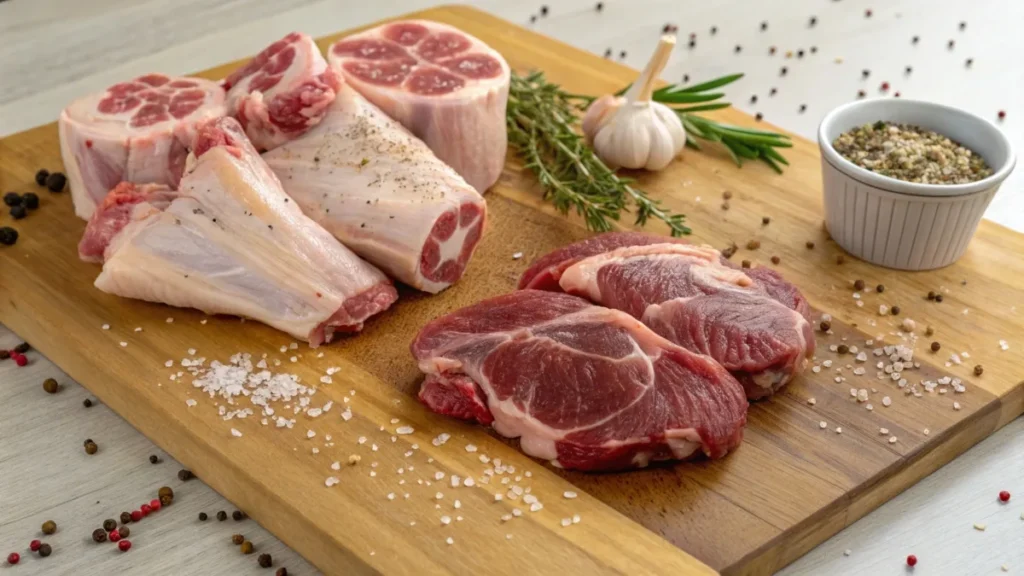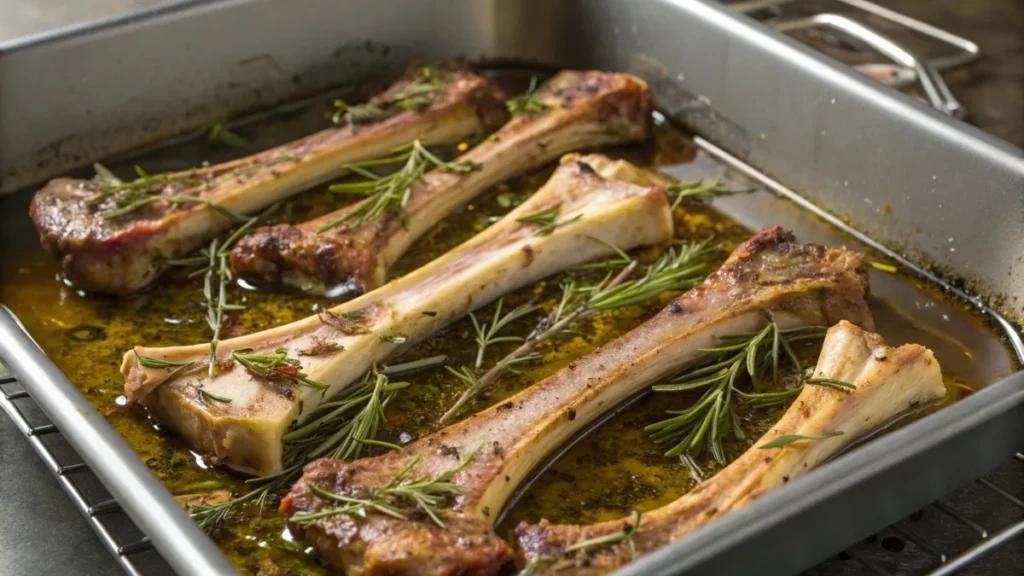Looking for the secret to making rich, flavorful soups that warm the soul? It all starts with a soup bone! These humble ingredients are the unsung heroes of the kitchen, transforming simple recipes into culinary masterpieces. Whether you’re after a hearty broth, a comforting stew, or a base for sauces, soup bones add depth and richness that’s hard to beat.
The best part? Using soup bones is super easy and incredibly healthy. Packed with nutrients like collagen, calcium, and amino acids, they’re a natural way to boost your health while enjoying delicious meals. Plus, they’re versatile—you can roast, simmer, or pressure-cook them to suit your favorite recipes.
Imagine the aroma of homemade soup filling your kitchen, creating comfort in every bite. Doesn’t that sound amazing? So, grab your apron, and let’s explore how soup bones can transform your cooking. Keep reading to discover everything you need to know!
Table of contents
- What Are Soup Bone and Why Are They Essential?
- Preparing Soup Bone for Maximum Flavor
- Nutritional Benefits of Using Soup Bone in Recipes
- Creative Recipes and Ideas for Cooking with Soup Bones
- Tips for Buying High-Quality Soup Bones
- Frequently Asked Questions (FAQs)
- Start Cooking with Soup Bones Today for Better Flavor and Health
What Are Soup Bone and Why Are They Essential?
The role of soup bone in traditional cooking
Soup bones have been a cornerstone of traditional cooking for centuries. They are the secret to creating rich and flavorful broths that enhance a variety of dishes. When simmered slowly, soup bones release their natural essence, providing depth and complexity to soups, stews, and sauces.
First, they offer a cost-effective way to utilize every part of the animal. This practice reflects the resourcefulness of traditional cooks worldwide. Next, soup bones are packed with nutrients like collagen and minerals, which are extracted during the cooking process.
In addition, they help create a silky texture in broths that no artificial ingredient can replicate. Using a soup bone not only improves flavor but also connects you to age-old cooking techniques. It’s like taking a step back in time while making something delicious and wholesome for today’s meals.
Types of bones ideal for soup-making
Not all bones are created equal when it comes to making soups. The type of soup bone you use can dramatically impact the flavor and quality of your dish. Beef bones, such as marrow bones and knuckles, are ideal for hearty broths. They release a deep, rich flavor that’s perfect for classic soups and stews.
Chicken bones are lighter and work well for clear soups or light broths. Pork bones, especially neck or ham bones, offer a slightly sweet and smoky flavor. If you’re feeling adventurous, try fish bones for delicate seafood broths.
Each type of bone brings something unique to the table, making it fun to experiment with different options. The key is to choose fresh, high-quality bones to ensure the best results. Once you try this approach, you’ll see why soup bones are a game-changer in cooking!

Preparing Soup Bone for Maximum Flavor
How to roast bones for rich and deep flavors
Roasting soup bones is a simple trick that can elevate your broth to a whole new level. Start by arranging the bones on a baking sheet. Drizzle them lightly with oil and roast them in a hot oven at 400°F for about 30 minutes.
The roasting process caramelizes the surface of the bones, creating a deep, smoky flavor that adds complexity to your soup. You’ll notice the bones turn golden brown, and your kitchen fills with an amazing aroma.
Next, transfer the roasted bones to a pot with water, vegetables, and herbs. Simmer them gently to let the flavors blend. Roasting not only enhances the taste but also gives your broth a beautiful, rich color. Trust me, it’s worth the extra step for your soup bone recipes!

Cleaning and storing soup bone for later use
Before cooking, it’s essential to clean your soup bones properly. Rinse them under cold water to remove any debris or blood. For an extra step, you can blanch the bones in boiling water for a few minutes to ensure cleanliness.
If you’re not ready to use the bones right away, store them properly. Wrap them tightly in plastic wrap or place them in an airtight container. Then, freeze them to maintain their freshness. This way, your soup bone stash will be ready whenever you need it.
Keeping your bones clean and fresh ensures you’ll always have a flavorful base for soups and broths. Plus, it’s a great way to reduce waste and make the most of your ingredients.
Nutritional Benefits of Using Soup Bone in Recipes
Vitamins and minerals extracted from soup bone
Soup bones are a powerhouse of nutrients. When simmered, they release vital minerals like calcium, magnesium, and phosphorus. These nutrients are easily absorbed by the body, making bone broth an excellent health booster.
In addition, soup bones are rich in collagen, which supports joint health and promotes glowing skin. The cooking process breaks down this collagen into gelatin, giving the broth its silky texture and nutritious benefits.
Drinking broth made from a soup bone can also replenish your body with essential amino acids. These nutrients support digestion, muscle repair, and overall wellness. It’s amazing how such a simple ingredient can provide so much goodness in every sip!
How soup bones support gut health and immunity
Did you know that a soup bone can help improve gut health? The gelatin extracted during cooking helps repair the gut lining, making it a natural remedy for digestive issues.
Additionally, the nutrients in soup bones, like amino acids and minerals, strengthen your immune system. They help your body fight off infections and stay energized.
Including soup bones in your diet is a simple and delicious way to care for your body. Whether you’re sipping on bone broth or using it as a base for recipes, it’s a comforting, nutrient-packed option you’ll love.
Creative Recipes and Ideas for Cooking with Soup Bones
Bone broth recipe ideas for beginners
Making bone broth with a soup bone is easier than you think. Start by placing bones, vegetables, and herbs in a large pot. Cover them with water, and let the mixture simmer on low heat for 12–24 hours.
The result is a flavorful, nutrient-rich broth you can use in countless ways. You can drink it as a warm, soothing beverage or use it as a base for soups and sauces. For added flavor, try including garlic, ginger, or apple cider vinegar in the recipe.
Bone broth is a versatile staple that every home cook should have on hand. Plus, it’s budget-friendly and incredibly satisfying to make.

Using soup bones in stews, soups, and sauces
Soup bones aren’t just for broths—they’re a key ingredient in hearty stews and rich sauces too. When making a stew, add your soup bone during the cooking process to infuse the dish with extra depth.
You can also use soup bones in tomato-based sauces, where the marrow creates a velvety texture. For soups, simmer the bones with ingredients like beans, lentils, or vegetables for a filling and flavorful meal.
The possibilities are endless, and experimenting with soup bones will open up a world of delicious recipes.
Tips for Buying High-Quality Soup Bones
Choosing the right bones for your recipe
When selecting a soup bone, look for fresh and high-quality options. Bones with a bit of meat still attached are ideal for stews. Marrow bones are perfect for creating rich, flavorful broths.
If you’re making chicken soup, choose a mix of wings, drumsticks, and carcass bones. For beef or pork, knuckles and shanks work best.
Also, pay attention to the color and smell of the bones. Fresh ones should look clean and have no unpleasant odor. Picking the right bones ensures your recipes turn out delicious every time.
Where to source organic or grass-fed soup bones
For the best flavor and nutrition, try sourcing organic or grass-fed soup bones. These bones come from animals raised on natural diets without hormones or antibiotics.
You can find them at local farmers’ markets, butcher shops, or specialty grocery stores. Some online retailers also offer high-quality soup bones delivered to your doorstep.
Using organic or grass-fed bones not only enhances the taste of your recipes but also supports sustainable and ethical farming practices. It’s a win-win for your health and the environment!
Frequently Asked Questions (FAQs)
Which bone is good for soup?
Choosing the right soup bone depends on the flavor you want. Beef bones, especially knuckles and marrow bones, create rich, hearty broths. Chicken bones, like drumsticks or wings, are perfect for light and clear soups. Pork bones, including ham or neck bones, offer a slightly sweet flavor that works well in stews.
Fish bones are ideal for delicate seafood broths, while lamb bones add a bold, earthy taste. For the best results, look for fresh bones with a bit of meat still attached. Also, mixing bone types can create even more depth in your broth.
What is the best bone for soup?
The best soup bone depends on your recipe. For a deeply flavorful broth, use beef marrow bones or oxtail. If you’re making a light soup, chicken bones, especially carcasses, are ideal.
Pork bones are great for stews or ramen-style soups, while lamb shanks add a unique, bold flavor. Fish bones are perfect for quick-cooking broths that taste fresh and clean. No matter which bone you choose, roasting them first enhances their flavor and color. Experiment to find your favorite!
Are soup bones good to eat?
Soup bones themselves aren’t typically eaten, but they’re amazing for cooking. Simmering them extracts their nutrients and flavor, creating delicious broths. However, marrow from beef bones is edible and packed with nutrients like healthy fats and vitamins.
Soup made with a soup bone is rich in collagen, which supports joint and skin health. The nutrients in broth, like calcium and magnesium, are easily absorbed by your body. While you won’t crunch on the bones, they’re essential for creating a nutrient-packed base for soups, stews, and sauces.
What is the difference between soup bones and marrow bones?
Soup bones are a general term for bones used to make broth. They can include knuckles, neck bones, or even shanks. These bones add flavor and nutrients to soups but may not contain marrow.
On the other hand, marrow bones specifically refer to bones with a hollow center filled with fatty marrow. This marrow melts into the broth, creating a rich, velvety texture. While all marrow bones are soup bones, not all soup bones have marrow. Both are fantastic options for making hearty, flavorful broths!
Start Cooking with Soup Bones Today for Better Flavor and Health
Cooking with a soup bone is one of the simplest ways to transform your meals. It adds incredible depth, nutrition, and flavor to every recipe. Whether you’re making bone broth, hearty soups, or rich stews, soup bones are a game-changer.
First, they’re packed with nutrients like collagen and minerals that support your health. Next, they create broths with unmatched flavor, perfect for enhancing any dish. Plus, they’re versatile—you can roast, simmer, or pressure-cook them to suit your recipe needs.
So why wait? Start experimenting with soup bones in your kitchen today. From cozy family dinners to impressive meals for guests, soup bones help you create unforgettable dishes. Give them a try, and you’ll see just how easy and rewarding it can be. You’re not just cooking—you’re unlocking a whole new level of flavor and nutrition! Happy cooking!
